
NEW BRUNSWICK

Woodstock
NO PART OF THE FOLLOWING
ARTICLE AND PHOTOGRAPHS
MAY BE REPRODUCED WITHOUT
PERMISSION FROM THE AUTHOR ©
(Also known as "Connell Park", "Exhibition Park",
and "Woodstock's Island Park".)
This amusement area was situated on a tear-drop shaped island in The Saint John River at the mouth of The Meduxnekeage River. (See the aerial photo near the end of this article.) It was 28 hectares in size. Before European settlement, natives used the island as a summer camp and as a base for salmon fishing. This lasted into the 1800s. When the Creek Area (as this part of present Woodstock was once known), was to be settled, Captain Jacob Smith was granted land in the area for having fought in the American War of Independence. He was allowed to choose the property he wanted as a reward for being loyal to the British Crown. He selected an expanse along the river's shore plus the entire "Island at Woodstock". So in 1784, he built a log cabin on land that later became occupied by the town of Woodstock. It was situated on the shore overlooking the island. (This area was one of the ones to later be covered in water, as discussed at the end of this article.)
Eventually, his son, Richard Smith, inherited some, and acquired other, parts of his father's land. His will in turn, provided that his wife be able to lease some of it and sell the rest. The island in The Saint John River ended up with Charles. R. Rogers. In 1890 A. B. Connell, executor of the estate of John W. Connell (another whose family had bought blocks of land from Richard Smith's widow), purchased the island from Rogers. A free public reserve was to be created for the benefit of the citizens of Woodstock. This was to be known as "Connell Park", although it's not known if John requested that name or if the public simply came to call it that.
There is some confusion as to the exact date this occurred because another source says that the land was not acquired until 1909. Regardless, a grandstand was erected and baseball diamond put in as recreation for island-goers. The southern, treed section of the island would become a picnic ground with a pump for water supply. A pre-World War I postcard shows picnickers and a horse-drawn vehicle in this area.
In 1918 the central portion of the island was leased to the Carleton County Agricultural Society for $1 per year until 1938, with an option to renew the lease. They wanted to transfer their agricultural exhibition to the island. Be aware that one source says the fair did not actually start to run there until the 1922 season, but four years just seems to long to lease the land without using it and a newspaper source gives a date of 1919 in which the main exhibition building was constructed. The 1922 date may be confused with the first year the miniature railway ran. (See farther on for discussion of the railway.) Regardless, the fair was held there in early September for decades. For at least part of the time, it was named "The Saint John Valley Exhibition".
The southern part of the island was kept as a picnic ground while exhibition structures were erected in the central area thanks to a $101,000 budget. One of these was a large, two-story, 1500 square-metre barn and exhibit building. It could house over 100 horses, plus have space available for cattle, pigs, poultry, and sheep. Also built was a horse race track with a regulation 20-metre wide home stretch and a large 2500-seat grandstand. Harness (sulky) racing was the main attraction at the track. It lasted until the park's demise where upon racing was transferred to the mainland.
|
Main Exhibition Building Interior 1930s  This gives an idea of how large the main building was. Only a small portion of the arena and stands are visible here. Flags include British and American. Others are unable to be discerned. |
At Center Bottom a man appears to hold a megaphone. In the days before PA systems were common, one used a hand-held horn to project the voice into a crowd. Behind that is a booth and window. It may have been for officials or possibly a food concession. |
A photo taken in the 1930s or 40s shows the entrance to the track with a two-story office in the foreground. A ticket kiosk in the shape of a large clown head wearing a derby, is situated in front of this building. The ticket window is the clown's mouth. To the left is a free-standing placard the height of the building. Painted on it is another full-length clown standing on a small box. He is holding a large ball off to one side of himself upon which are the words "Grand Stand", and the whole thing is cut out in the shape of this clown and the ball. It's unknown if these were there from the start of not, but one source credits Wentworth Stone as the painter.
There was also a "driving club" that called the island their home, but it's not yet entirely clear what they were driving. A 1920s or 30s photo shows the Exhibition Building with a large number of people and automobiles of the era. Car "touring" was popular at the time, so the driving club may have referred to automobiles. Opposing this idea is a photo which shows a harness race in progress with a "W. D. Club" (Woodstock Driving Club) pennant flying above the judges' stand, so the "driving" may have referred to sulkies, a two-wheeled wagon that held one person that was hitched to a single horse.
Road access to the park was gained from a long steel bridge that crossed The Saint John River. It passed over a muddy area on the north side of the island called "Sucker Flat". A ramp lead up on to the bridge from here. It's not known if this bridge and its ramp were built in conjunction with the island's exhibition or if the bridge just happened to be in a handy place and the ramp was added afterwards.
Note that Alden Sewella of Jackson, Georgia, U.S.A. who grew up in Woodstock says: "Sucker Flat was not part of the Island; it was a mainland area to the west of the island about half a kilometre wide and a couple long."
Island Park did not have many permanent amusement devices, so each year for the exhibition, carnival rides were brought in. One source thought that Bill Lynch shows was the carnival provider for at least part of the park's run. (See Findlay's Pleasure Grounds for Lynch information.) Rides came to include bumper cars and a ferris wheel, along with a "House of Horrors" and a funhouse. There were games and a bingo tent. Because of the presentation nature of the island, and the yearly fair, it was often referred to as "Exhibition Park".
Side shows had a bearded lady, a sword swallower, and a frozen "body" that was supposed to be a Sasquatch or similar. The side show also had "girlie" tents featuring burlesque shows that were the forerunner of today's strip clubs. In keeping with the exhibition, there were bake displays, preserves, along with vegetable and animal contests similar to modern rural fairs. There were also other events that would run in the summer so a midway was often set up for such times. Even without any special events, the sports facilities were used throughout the warm season.
The Miniature Railway
Despite the semi-permanent nature of this midway, there was at least one permanent ride: a miniature steam railway. It would run on Saturdays and holidays, as well as during the exhibition and other events on the island. The locomotive and cars for it had been built by Woodstock native Albert (Ethelbert) Wort. He was the town's lamplighter as well as the water works superintendent and engineer.
Albert improved the existing systems plus designed and built new equipment. The water plant's pumps were steam powered, so he drew upon this experience and expertise to construct a miniature railway locomotive and rolling stock from scratch. He had his own shop there where he built everything in his spare time. He also built and sold skis, toboggans, sleds, and pedal cars. (As a related aside, see the article on the Woodstock Toboggan Run.)
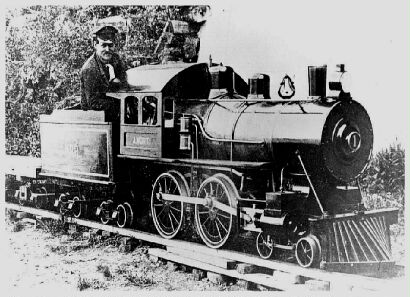
Starting with self-drawn plans in the 1890s, Albert built a steam locomotive, a tender, rolling stock, and a track layout - all over a period of 16 years. He personally did the casting and machining, with the exception of the most demanding castings, which were done at the local Dunbar Foundry.
The first of what would eventually be four locomotives, was a twenty-five horsepower, 4-4-0 configuration utilizing water-tube boilers. It was said that this was the first rail locomotive to use such a method to produce steam. It ran on the mainland on a test track from the Water Works to the Saint John River bank starting no later than 1910.
Train Number 1 ran two wooden-body cars, each about 5 metres long. Seating capacity per car was 12 adults, while the engineer sat in the front part of the tender. All ran on a 419-millimetre gauge track bought from an Ontario mining company which had run a narrow-gauge rail system. (Standard gauge in Canada for a full-size railway is 1435mm.)
Albert ran and maintained everything himself, although his family was also involved. Albert had three sons and six daughters. Sons Donald and Gordon helped with the construction, and then later drove the trains when they moved the railroad to Island Park. Donald would drive Engine Number 1, with Gordon on Number 2. The third son, Allan, was involved, but only on rare occasions. All the girls sold tickets and worked at the Station Canteen at one time or another. Non-family personnel were also employed to operate the trains. One was Woodstock resident Maurice Craig, a Canadian Pacific Railway locomotive engineer.
|
The Original Wort Locomotives 1920s ? 
|
These are Wort's first locomotives. Here they pull in tandem, with #1 in front. Part of one of the covered passenger cars is visible at Center Left. The 4-4-0 configuration of the first locomotive is evident in this photo. |
The first train and a second two-car unit built by Wort also ran in the town park near the Canadian National Railway station for 1920 and 1921 (only 1922 from another source). The test track was not used at this time. Train Number 2 consisted of a steam locomotive similar in design to the first, but in a 4-6-0 wheel configuration. Its rolling stock consisted of three cars: two of the 12-passenger cars and one shorter, 3.7-metre car for eight passengers.
It's not clear when this second train was built. A second reference conveys that the first locomotive was not started to be built until 1913 and did not run until 1920, but this is clearly wrong, as there is a 1910 "Carleton Sentinel" newspaper article detailing the miniature railway. Plus in an interview, Albert Wort alluded to having built the first locomotive and rolling stock in at least the 19-0s, and likely earlier. Remember that sources said he spent 16 years on the first, and since a newspaper article gives 1910 as the latest first-running year, that makes the project start-year at least 1894 and possibly earlier. Based on this, the 1913 - 1920 dates appear to be for the second locomotive and cars.
Regardless of when the trains were built, they were transferred to the exhibition grounds on Island Park starting in 1922 (1923, according to Gordon Wort), where they remained as a permanent attraction. (Another source gives a start year for the island railway as 1921, but that may have been when Albert began track construction, with the opening not happening until the following year.)
On the island, Wort's creation became known as "Island Park Railway", although at least two locomotives had "Miniature Railway" stencilled on their tenders. The layout consisted of about 800 metres of track leading from the bridge ramp to the Exhibition Building near the midway. At the park end was a turntable and a five-stall roundhouse, while at the bridge end of the route was a siding, and presumably a loop and switch. Thus, the main route ran on the same track in both directions. (Some sources give a 1600-metre length, but this may refer to the complete trip length for both directions, not to the total track length. Additionally, the Canadian Railway Historical Association gives a length of 2400 metres. Perhaps these larger figures include sidings and storage tracks. Or maybe the larger figures represent a later, extended layout.)
Stations were situated at each location, one of which was named "Tipperary", and a uniformed engineer and conductor would run each train. There eventually came to be a 30-metre tunnel, a similar length bridge, and an illuminated trestle as part of this layout. Level crossings had warning signs, just as with full-size railroads. The roundhouse for storage & maintenance and a rail siding made up the main yard. At each terminal were water towers and coal storage. At the main yard were a canteen and ticket office. A sign above read "Island Park Railway Station".
|
Miniature Railway Main Yard Mid 1930s ? 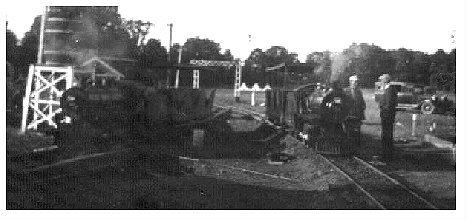
|
|
Here is the main yard for the park's miniature
railway. At Lower Left is a turntable with
one of the engines partly on it. Behind it is
a large barrel on a short tower. It was for
supplying water to the locomotives. To the left,
out of frame, is the roundhouse. The Exhibition
Building and Canteen lie out of frame to the
right.
Both tracks moving away from you combine via a switch and the resulting single track leads to Tipperary Station at the park's entrance. Note an automobile of the era at Center Right, background. |
|
Railway Turntable 1930s 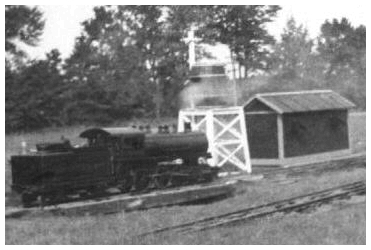
|
This shows another angle of the turntable. |
| A faded photo of the island's entrance station. What is the row of white items at Center Right? |
Tipperary Station 1920s 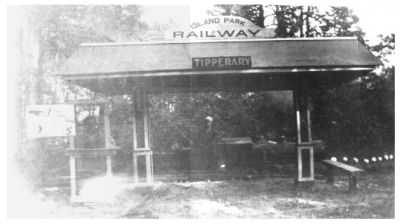
|
Train rides were initially 5 cents per one-way but had changed to 10 cents a round trip by the late 1920s. One of the ticket sellers was Millard Dow but it's unknown if Millard was on the mainland or the island, nor what years he did this. The trains would even run after dark, ferrying passengers from the exhibition grounds to the bridge ramp. On-board lighting was powered by a 12-volt automotive battery.
As the park neared the end of its first lease, both trains were sold and transported to India where they ran between a prince's palace and the local post office. This happened in 1936 (1937 from another source). Albert then built two more to replace them during 1937 and 38. These were ready to run for the 1938 season, so no trains ran during 1937. Considering the money from the sale and the quick construction, it would seem that Wort hired some helpers to assist in the building of new units. His sons were certainly among them, if not the only workers.
|
Island Park Train Mid 1930s 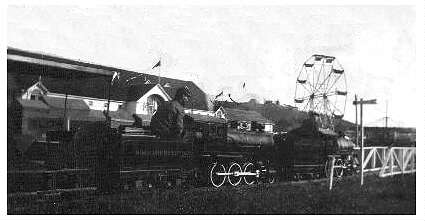
|
Wort's trains pass in front of the Exhibition
Building. Number 1 leads while Number 2 trails.
The latter's 4-6-0 configuration may be plainly
seen.
|
|
Note the small railway bridge at Lower Right.
After crossing that bridge, the trains would
arrive at the main exhibition area where they
would be rotated around for the return journey.
A midway ferris wheel is in the background at Center Right. |
These replacement models had improved boilers capable of higher pressures and utilized triple superheaters. They could use coal, oil or wood as fuel, and they incorporated steam brakes. Their wheel configurations were 4-6-4 for Engine #3 and 4-6-2 for #4.
The new locomotives were black in colour with aluminum, brass, and/or copper trim and weighed about 1.4 tonnes each. Their new cars were larger, seating eighteen passengers, and were red in colour. Unfortunately, they ran only for one season or so before world events caused the exhibition to be put on hold.
Wort's work did not go unnoticed and he was awarded membership with The American Institute of Inventors (also shown as The "New York Inventors Club" by one source). That accolade was bestowed on September 28, 1939.
|
Exhibition Building Station 1930s 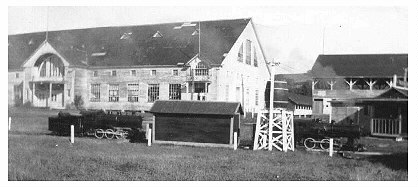
|
|
Another shot of the Exhibition Building and
engines shows the small structure between the
locomotives (apparently used for coal storage),
and to its right, the water tower. Locomotive
#2 is to the left of the small structure; #1 is
to the right of the water tower just entering
the turntable. The left side of the canteen
building is visible at Center Right, above &
behind the turntable. It housed a ticket office.
Note the small dormers on the Exhibition Building's roof, and also what appear to be missing shingles. The other building in the background beyond the water tower barrel is currently unidentified, but may be the main office. |
|
Turntable 1930s 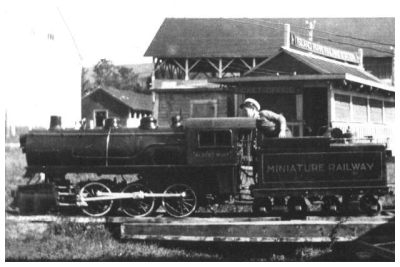
|
Here is a closer view of the turntable and Engine #2. A sign above and behind the engineer says "Ticket Office". To its right is the Canteen. A more straight-on shot of it is farther on. |
| The turntable and roundhouse are seen here from the opposite side and much later in time. Engine #4 is on the table about to move inside. This higher angle photo was likely taken from the roof of the Canteen. |
The Roundhouse 1938 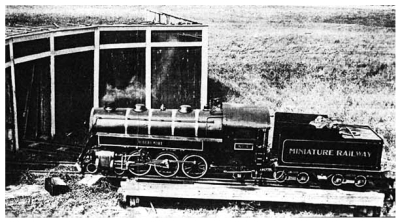
|
|
The Roundhouse 1938 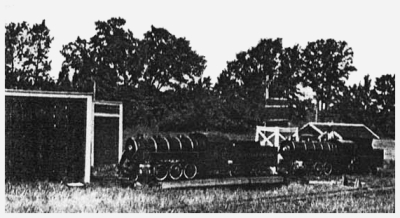
|
Again from the Canteen side, a lower angle of the turntable and roundhouse are seen. Engines #3 & #4 are on the track. |
The European Conflict
War broke out in Europe in early September, 1939. Although Canada did not officially declare war until September 10th, preparations had actually begun earlier. The exhibition was cancelled to make way for immediate training on the grounds. On September 4th, the Carleton-York Regiment headed by Lieutenant Colonel H.N. Ganong was mobilized at the park as infantry and artillery units. 4,000 New Brunswick citizens were ordered to report for active duty. They became part of The Canadian Active Service Force.
When the first forces were ready, the Canadian war office sent an army division to Europe via ship convoy. Since the regiment at Island Park had been training from an early point, it was ready sooner and became part of that first wave. It travelled via train from Moncton to Halifax whereupon it left on December 10th via convoy. This consisted of five troop ships escorted by four destroyers which passed the troop ships off to a Royal Navy flotilla part way across. The convoy arrived without incident in Greenock, Scotland on December 17th. The initial man off one of the ships (The "Monarch of Bermuda") was Sergeant Bernard Gregson of Milltown, New Brunswick, making him the first Canadian soldier to land in Great Britain at the start of World War II.
Since the Woodstock exhibition did not run from 1939 through 1945, the miniature railway was out of service during that time, although it may have run for a period early in the summer of 1939. Albert Wort unfortunately never got to see his beloved train system operate again. He died of a heart attack November 26, 1941 at age 67. (Another source gives his age as `66'.)
Despite no exhibition, some entertainment was still provided for those encamped on the island. One was clown, Leverett Stone. Until 1952, he was employed locally by The Canadian Pacific (National?) Railway and was in charge of the engine roundhouse. In his clown profession, he was known as "Tip" and performed in the Woodstock area for many years. His other talents included magic and ventriloquism, and he later could often be seen in the Old Home Week parades every summer. It should be noted that the painter of the grandstand's clown signs, Wentworth Stone, was Leverett's son.
After the war, the society resumed the exhibition starting with the 1946 season. One of Albert's sons, Gordon Wort, decided to try to get the miniature railway running again. Unfortunately, with no supervision, bored soldiers in training on the island had tried to run, or outright vandalized, the trains during the years the park did not operate. Consequently, they required much work.
Gordon persevered and was able to restore the railway to operating status. However, with little capital available and being unable to secure any investors, it's not known if the railway ever operated commercially at Island Park for any time after the war. Regardless, the trains and perhaps some of the track were eventually sold to Lewis Bearce in Caribou, Maine for $1500, where they ran for a bit. After Lewis died, they next went to North Carolina, with no word as to where they are now. Considering that only four Wort locomotives were ever made, they'd be worth a fortune to collectors today -- if any still exist. (See farther on for comments from Alden Sewella and Mark Reid regarding remaining track.)
|
Island Park Station Canteen 1930s ? 
|
This shows the Canteen next to the main exhibition area. In fact, the Exhibition Building's roof may be seen above the canteen's roof at Upper Right. The main railway yard would be to the left, out of frame. |
In 1946 the Exhibition Building burned. It was replaced with a simpler pitched-roof building that was one story along the sides but rose to two, or slightly more, stories at the roof peak.
A 1949 or early 1950s aerial photograph below shows the island ringed in trees with a clear, flat central area. One larger grove at the southern end indicates where the picnic grounds had been established. The race track is clearly visible with a fenced-in baseball field and diamond in the center. Also seen is the new Exhibition Building and over a dozen other structures. Near one side of this area, close to the perimeter tree line, are three other buildings or tents. An unpaved roadway runs from this area past the Exhibition Building area and through a grove of trees at the north end of the island out to the access ramp to the bridge.
No boat docks are visible in the photo, but there are some other paths/roadways that run around the island and one of those may lead to an unseen dock. There is no sign of any remaining miniature railway tracks, so they are either too small to be resolved in the photographs, overgrown with grass, or more likely the ones that might have been visible were those that were removed and sold with the trains. This may not have happened though, because researcher Mark Reid found one of the rails during a 2005 trip. (See the "Update" at the end.) There is however, a faint, thin line visible in a higher resolution version of the photo that may indicate tracks or where some might have been.
|
Island Park 1949 or Early 1950s The Meduxnekeage River flows through the town of Woodstock at Lower Right. It passes under the rail bridge and into The Saint John RIver. The bridge that crosses The Saint John passes over the mud flat where the ramp to the island can be seen. |

|
 Ron Garnett Photo |
|
Flooded Island Park circa 2001 A hydro-electric project would flood Island Park in the 1960s. The aftermath seen here shows only a few remnants left above the water. The small island with its crown of trees at the right of Top Center marks where part of the picnic grove was. The other small parcel of land to its right is not likely part of Island park but is higher mainland that was not flooded and now juts into the river. Note the changes after half a century to the shoreline at the lower right. The mouth of The Meduxnekeage River has been widened and the rail bridge extended. Saint John River frontage has been pushed back near there except for a rectangular area of reclaimed land. |
No information has yet surfaced on the park for the 1950s except that a swimming pool was installed at some point. A late 1950s or early 1960s photo shows Little League baseball teams marching down the ramp from the bridge to the park. They hold placards with team names: "Indians","Yankees", and a third name that is unresolvable.
|
Trailers park next to the far end of the race track and along the roadways. The intersection of the two roads and the race track edge may be seen in the first aerial photo farther back. At Center Top is the picnic grove, while at Upper Right beyond the trees lies the Saint John River and the mainland. |
Campers' Village Early 1950s 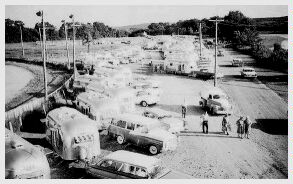
|
Alden Sewella reminisces from around 1960: "Coming down the ramp to the island on the right was an empty area where once or more a year the YMCA (Young Men's Christian Association) staged a chicken barbeque. Then a little farther along was a playground with green teeter-totters, swings, sand boxes and maybe some horse shoe pins. Just past the playground and across the road was a band shell where the Reserve Army Band played a few times in the summer."
"Down by the grand stand were a few metres of the old train track and an old, small shack on the left. Across the road were some outhouses with a typical setup except there were eight to ten stalls with a long trench in the ground below. A hundred metres down the way the road ended; however a dirt trail went on for another few hundred metres to some butternut trees and quite a number of chokecherry bushes."
Might the shack of which Alden speaks have been the remains of the small maintenance bulding seen in the "Exhibition Building Station" photo farther back? Also, his comment about visible rails suggests that at least some the track was not included in the sale of the Wort trains.
Alden continues: "Going along this dirt path one came upon a small aircraft hangar where a man kept a biplane, and every once in a while we would see it come or go. My guess is that it was the first airplane many people ever saw. Years later I became an airline maintenance engineer and Inspector while my brother forged a career in the R.C.A.F (Royal Canadian Air Force)."
"At the North end of the race track oval were stalls for the horses. There was a line of several of them running east-west a short way off the track. In summer we had several races with the sulkies."
Alden also remembers a swimming area at the edge of the island: "Did you know there was a rocky beach at about the middle of the east side of the island? The girls changed in the trees to the left and the boys in the trees to the right."
A New Brunswick Travel Bureau brochure, most likely published sometime between 1961 and 1964, lists Island Park and states it had the swimming pool, and picnic & camping sites. An accompanying photo in the travel brochure shows harness racing on a track. A ring of trees is visible behind the track's spectators that continues on behind the amusement area in the far background. There, a ferris wheel and barn-like building can be seen. The latter was likely the Exhibition Building constructed in the late 1940s or in 1950. A third structure seen may be the central support of another amusement ride.
The travel brochure also mentions an "Old Home Week" event each year in early August. The text implies this event was then recently new, indicating a late 1950s or early 1960s start. Since the exhibition's leases seem to have been in 20-season stretches and the first ran from 1918 through 1937, then presumably was renewed from 1938 through 1957, a third lease may have commenced in 1958. That could have been the start year for Old Home Week. If a third lease was started, it may have been terminated or bought out in the mid 1960s in anticipation of a river power project that would flood the island. (See farther on.) However, was a third lease actually started?
Given the World War II gap, the second lease may have been terminated in 1939, and thus a third lease could have started anew in 1946. If so, that would have ended in 1965. A third speculation is that the second lease was just suspended in 1939 and then resumed in 1946. With 18 or 19 seasons left to go, depending on whether the 1939 season was counted or not, this places an end to that lease in 1963 or 64. Whichever the reasoning here, the official lease would end right around the time when the power project started. If the lease ran out on its own, the park was likely on a year-to-year basis until being closed just before the dam was to be put into use, flooding the island as water backed up.
The Hydro-Electric Project
Regardless of how the leases ran, the park's demise was foretold in the early 1960s when a hydro-electric undertaking was planned by New Brunswick Power for The Saint John River. (This river has many such projects.) It would include a dam about 80 kilometres down river at Mactaquac which would have a power output of 300 megawatts (later 600 MW). This dam would raise water levels upstream of it and unfortunately inundate Island Park. The project was begun in 1964 and completed in 1966.
The last season for Island Park was likely 1966, although one source says the river was not flooded until 1968, meaning a possible 1967 season. Save for an area at the southern end of the island and a small, flat island at the northern end, It now lies under five metres of water, as does the mainland site of the log cabin of original island owner, Jacob Smith. The bridge crossing the river at Woodstock, which gave access to the island via the ramp, was removed and not replaced.
A 1984 New Brunswick Tourism brochure no longer shows Island Park. The Old Home Week event was still listed (July 28 - August 4 that year), and harness racing was shown as occurring at Connell Park on the mainland. This is where the exhibition continues to be run to this day.
UPDATE August 2005: Mark Reid, who lives near Centreville just northwest of Woodstock, was able to get on to the island. The Saint John River level was very low at that time, exposing quite a bit of the land. He saw concrete forms where buildings used to be and one of the rails of the miniature railroad sticking out of the ground. So apparently another one of the rails never went with the second group of locomotives when they were sold, if any track went at all. Mark also obtained some metal fittings. They are reproduced below.
|
Metal Artifacts from the Island 2005 
|
These appear to be wrought iron fittings from the grandstand seats or possibly they are from park-style benches that may have been on the island. |
|
Thanks to Kelly Copeland of Barrie Ontario for suggesting this
park and providing initial information. She in turn, wishes to
credit part of her information as coming from the book "A
Woodstock Album". Thanks to a long-time resident of Woodstock (who wishes to remain anonymous), for relating personal recollections. Special thanks to the staff of the L.P. Fisher Public Library in Woodstock for photos and information on the miniature railway. A big thankyou to Woodstock's Robert Wort (Albert's grandson) and his father for the many corrections and additions regarding the miniature railway. Train photos are also courtesy of Robert. For a negative look at The Mactaquac Dam project, go to: The Destruction Of A River. (Note that both French and English language versions are available, one after the other.) |
Return to the
Closed Canadian Parks Index
